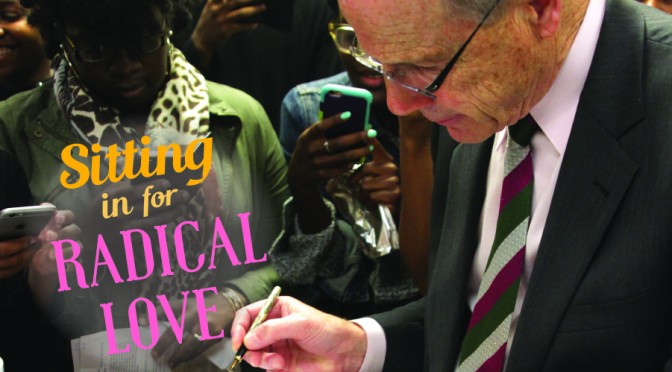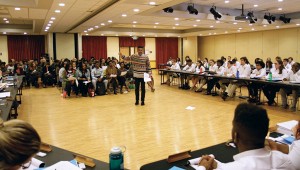
#OccupyTowson happened. So now what?
By: Carley Milligan, Editor-in-Chief
Towson students John Gillespie and Korey Johnson have a history of activism on and around campus. In April, they organized a student march in downtown Baltimore in response to the death of Freddie Gray, on the first day of classes they gathered with students in Freedom Square to provide a safe space and, most recently, staged two sit-in style protests.
“My number one principle is that activism has to be an act of radical love,” Gillespie said in an October interview with The Towerlight.
Two weeks ago, Gillespie, Johnson and a group of student activists showed Towson’s campus and community what radical love looks like to them.
They presented a list of 13 demands, which aimed to improve the quality of life for the community of diverse students on campus, to both the Student Government Association and then to the University administration in two consecutive sit-in style protests on Nov. 17 and 18.
SGA President Kurt Anderson signed the demands, which hold the SGA and administration accountable for their promise to address the concerns. Then, following almost nine hours of negotiation, Interim President Timothy Chandler signed a revised version of the same document.
“A lot of the backlash we got from this event was that it was radical, but deconstruction is radical,” Gillespie said.
The student activists said their demands will address concerns of students on campus, in particular those in the black community, by addressing the roots of the problems.
Johnson said that while eliminating smaller conflicts like microaggressions, which are small occurrences of hostile or derogatory slurs, is important to them, correcting what she called “structural antagonism” in the University’s system is a priority.
For many of the students, the combination of frequent microaggressions, in addition to larger systematic concerns, such as the low number of black professors who have received tenure at the University and a lack of cultural competency classes, have fostered their desire to join this movement toward change.
Some consider 2012-13 as a high water mark for the racial tension on campus due to the founding of “The White Student Union,” headed by Towson alum Matthew Heimbach.
Johnson said those events, among others, have shaped her perspective of the culture of Towson’s campus regarding race relations.
“I can’t just forget the things that have happened to the debate team,” Johnson said. “I can’t forget that Matt Heimbach and his posse … were patrolling [campus] to make sure that black men didn’t rape white women and I was afraid to go to my dorm. All of those different things created for me a narrative of what Towson is.”
For student activist Bilphena Yahwon, her experiences at TU have fostered her desire to join the movement.
Since she arrived at TU in 2011, she has been involved in a number of various multicultural groups, held a position on the Council of Diverse Student Organizations, taken part in campus teach-ins and meetings, and worked with a number of faculty and staff.
“We have sat with University members and professors and said, ‘We have a problem we need to fix it,’” Yahwon said. “We have done that for four and a half years. Then when we finally explode people are like, ‘Oh my God. We didn’t see that coming.’ We had a White Student Union, and you wanna tell me you didn’t see this coming?”
Yahwon feels that her anger is warranted, yet said she believes some people in the campus community don’t understand why.
“I think because they see our black rage that for them this level of anger means that we are disorganized, that we are wild, that we are crazy,” she said. “We earned our black rage and that’s what people don’t understand. I will not apologize for screaming at anybody because people don’t understand that I have been doing this for four and a half years.”

After the list of demands was publically released, Yahwon said that some people responded with shock that the document was “clear and concise.” She speculates that the radical nature of their protests obscures the organization behind the movement for those on the outside looking in.
“We didn’t just get up one day and decide we are going to go occupy the president’s office,” Yahwon said after the Nov. 18 sit-in. “We did our research, we knew what we were doing. Everything we do is intentional.”
Gillespie said that they planned every action within their movement as a team so that they would be able to most effectively convey their message. During their Nov. 17 “SGA Takeover,” they planned their rebuttals and narratives to create a debate that used both logical and emotional factors.
The two sit-ins took place a week after the multiple protests at the University of Missouri, which led to the resignation of University of Missouri System President Timothy Wolfe.
Both Johnson and Gillespie said that for them, the argument that what happened at TU only happened because of what happened at Mizzou, does not negate the fact that the concerns they have raised in their list of demands are still relevant to Towson.
“Even if we are only doing it because Mizzou did it, which we are not, but even if that was the case that doesn’t take away from the necessity of it needing to be done,” Johnson said.
Gillespie also addressed that even as a black student, because he is a heterosexual cisgender male, he is still free of the discrimination that LGBTQI students face. He said hopes to work more closely with the other diverse student organizations as the movement progresses and make the safe spaces at Towson even safer.
Gillespie, Johnson and Yahwon encourage students to ask questions about the movement and demands in order to better understand its origin and goals, and hope to see the University take a more active approach in addressing these concerns.
“It’s love,” Yahwon said. “We are doing this for everyone and we are putting ourselves as leaders on the line for everyone … while our main focus is black students … all students will benefit from what we are doing and I really want people to realize that.”
***
Chandler signed the document around 12:45 a.m., after hours of deliberation and negotiation over the terms.
“It was a long and very, very important process that we went through, both learning from each other and I think putting the University in a better place in terms of understanding and appreciating their problems,” he said.
The Nov. 18 protest followed a “SGA Takeover” the previous night.
At the SGA meeting, students expressed that Anderson and his executive board, which ran on a platform of improved accessibility, transparency and diversity within the SGA, were not upholding the promises they made to the student body that elected them.
They hoped to hold the SGA accountable for their promises by asking for increased communication between SGA members and organizations, specifically diverse and multicultural organizations.
For example, they expressed dissatisfaction with the performance of the Director of Diversity Outreach, Xiomara Gonzalez, who said during the meeting that she had tried to get in touch with some of the groups via email but received no response. The students in turn argued that as a part of her job she should have sought them out in person rather than relying on virtual communication.
Anderson said that although there is always more work that can be done, Gonzalez is currently fulfilling the expectations of her position. SGA will be providing her with more resources and according to Anderson, she is doing more outreach work than others in her position have done in the past.
Johnson reminded students that they have the right to impeach any member of the SGA who is not meeting the job requirements. She asked them to put pressure on the SGA members who are paid, since every full-time undergraduate pays $84 in SGA fees, part of which goes toward the paychecks some members of SGA collect.
Gillespie said that as an activist he is not “against the SGA,” but wants the individuals who represent him to understand what matters to him and other students.
“I was very happy with myself and with the way our SGA handled it,” Anderson said. “I felt like we were very professional and we did our job of hearing students out, and obviously we are working to address everything that they talked about.”
The negotiations in Chandler’s office addressed every concern expressed in the demands. Among these were a notable lack of tenured black faculty members and diversity within the committees granting tenure, a need for a required cultural competency course for all of the colleges and departments, the incorporation of a required race relations course for all students, and a dissatisfaction with what the students consider to be inadequate representation on the President’s Diversity Coordinating Council.
Since the two days of on-campus protest, Anderson, Chandler and Gillespie have all released public statements via their organization’s websites or through The Towerlight.
Part of the agreement Anderson and Chandler signed was to release a statement, and in their comments both reflected on the efforts of the student activists as positive and reinforced their pride in both the students and the University for working together.
Chandler’s statement also reinforced the fact that the objectives were of mutual importance to both the students and the University and, in many cases, aligned with issues that are already actively being addressed.
Anderson’s statement discussed the steps that the SGA has taken so far to begin addressing the demands such as the formation of a task force, chaired by Chief Justice Michelle Harrison, and an informational website that will provide updates on the SGA’s progress.
One of the demands was for Chandler to advocate in the University System of Maryland to terminate contracts between the USM and the Maryland and Federal prison systems in which USM schools purchase furniture and other items produced by prisoners.
Since signing the document, Chandler sent a request via email to President of the USM Student Council, Gayon Sampson, who is also a Towson student, asking him to consider reviewing the contract for termination.
In a Nov. 24 response, Sampson said that after initial research and discussion, the council’s executive board has determined not to advocate for the termination of the contract.
Sampson said that the council’s directors of diversity and inclusion and governmental affairs have formed a taskforce comprised of student government presidents from each institution in the USM system to further investigate the contract, and draft a public and final report no later than March 1, 2016.
On Nov. 30 a TU Diversity Work Session was held in the Potomac Lounge where students and the President’s Diversity Coordinating Council were able to discuss the current climate of diversity on campus.
Visit thetowerlight.com for an upcoming article on this event.

